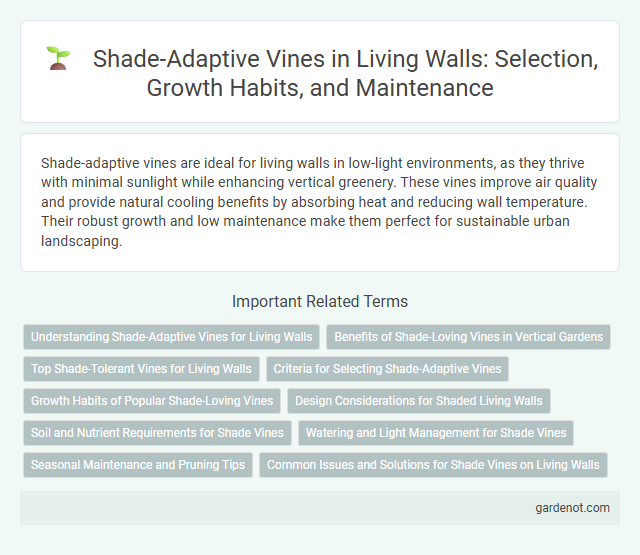Shade-adaptive vines are ideal for living walls in low-light environments, as they thrive with minimal sunlight while enhancing vertical greenery. These vines improve air quality and provide natural cooling benefits by absorbing heat and reducing wall temperature. Their robust growth and low maintenance make them perfect for sustainable urban landscaping.
Understanding Shade-Adaptive Vines for Living Walls
Shade-adaptive vines like English ivy and climbing hydrangea thrive in low-light conditions, making them ideal for living walls in shaded areas. These plants exhibit specialized leaf morphology and pigment adaptations that maximize photosynthesis under limited sunlight. Incorporating shade-tolerant species enhances the sustainability and aesthetic appeal of vertical gardens in diverse lighting environments.
Benefits of Shade-Loving Vines in Vertical Gardens
Shade-loving vines in vertical gardens enhance air quality by filtering pollutants and producing oxygen, creating healthier indoor and outdoor spaces. These shade-adaptive plants reduce heat absorption on walls, lowering cooling costs and providing natural insulation. Their lush foliage increases biodiversity by supporting pollinators and beneficial insects, contributing to a balanced ecosystem.
Top Shade-Tolerant Vines for Living Walls
Shade-tolerant vines like English ivy (Hedera helix), Periwinkle (Vinca minor), and Climbing hydrangea (Hydrangea anomala petiolaris) thrive on living walls with low light conditions. These vines exhibit remarkable adaptability to shaded environments by maintaining dense foliage and vigorous growth without direct sunlight. Incorporating such top shade-adaptive vines enhances vertical green spaces by promoting biodiversity and improving air quality in shaded urban settings.
Criteria for Selecting Shade-Adaptive Vines
Shade-adaptive vines must demonstrate strong tolerance to low light conditions, thriving in environments with limited direct sunlight while maintaining vigorous growth. Selecting species with robust root systems and moderate water requirements ensures resilience and sustainable establishment on living walls. Preference should be given to native or well-adapted plants with dense foliage that effectively enhances vertical greenery and provides natural insulation.
Growth Habits of Popular Shade-Loving Vines
Shade-loving vines such as English ivy (Hedera helix) and climbing hydrangea (Hydrangea anomala subsp. petiolaris) exhibit vigorous growth habits suited for low-light environments, often clinging tightly to surfaces with aerial rootlets or twining stems. These vines adapt well to vertical surfaces by spreading laterally and vertically, enhancing the aesthetic and ecological value of living walls without the need for direct sunlight. Their ability to maintain dense foliage in shaded areas makes them ideal for creating lush, green facades in urban and indoor settings.
Design Considerations for Shaded Living Walls
Shade-adaptive vines such as English ivy and creeping fig thrive in low-light conditions, making them ideal for shaded living walls. These vines exhibit robust growth and dense foliage that enhances vertical green coverage while minimizing maintenance requirements in reduced sunlight areas. Proper selection of shade-tolerant species ensures sustainable plant health, moisture retention, and aesthetic appeal in shaded urban environments.
Soil and Nutrient Requirements for Shade Vines
Shade-adaptive vines thrive in well-draining soil enriched with organic matter to retain moisture without waterlogging roots. These vines require nutrient-rich substrates, specifically high levels of nitrogen and potassium, to support lush foliage and robust growth in low-light conditions. Regular soil testing ensures balanced nutrient availability, preventing deficiencies that can hinder photosynthesis and overall vine health.
Watering and Light Management for Shade Vines
Shade-adaptive vines require moderate, consistent watering to prevent root rot while ensuring soil remains moist but not waterlogged. These vines thrive under indirect or filtered light, mimicking natural shaded environments with partial sun exposure for optimal photosynthesis. Proper light management involves placing the living wall in areas receiving dappled sunlight or using artificial shade solutions to enhance vine growth and longevity.
Seasonal Maintenance and Pruning Tips
Shade-adaptive vines like English ivy and Boston ivy thrive in living walls with low light, requiring seasonal maintenance to promote healthy growth and prevent overgrowth. Pruning should be done in early spring to remove dead or damaged stems and again mid-summer to control size and encourage dense foliage. Regular inspection and selective trimming improve air circulation and help maintain the aesthetic appeal of the living wall throughout the year.
Common Issues and Solutions for Shade Vines on Living Walls
Shade-adaptive vines on living walls commonly face challenges such as insufficient light leading to sparse growth, increased susceptibility to pests, and fungal diseases caused by damp, shaded conditions. Solutions include selecting tolerant species like English ivy or creeping fig, improving air circulation through strategic spacing, and implementing drip irrigation systems to minimize excess moisture. Regular pruning and monitoring for pests also enhance vine health and ensure lush coverage on shaded living walls.
Shade-adaptive vine Infographic

 gardenot.com
gardenot.com